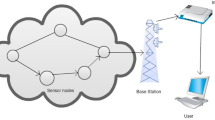Abstract
In this paper, we focus on the various aspects related to synchronization in wireless sensor networks, their features and how to increase the lifetime of the sensor and network nodes. The focus is about clock synchronization, delay measurement in time synchronization and fine grained network time synchronization. The recent advancements in the sensor technology has led to the miniaturization of the sensors and its related components, and similarly reduced the cost to a larger extent. This enabled an active rise in the research of large scale networks of sensors. The synchronization of sensor nodes is critical to its effective operation especially the time synchronization, for the data fusion, duty cycling and so on. Most of the algorithms for synchronization that were proposed recently do the same work. The server periodically sends a piece of information or message that contains the current value of clock to the client. This happens in case of time synchronization of the sensor nodes. The proper definition for sensor networks comes as follows. It is a special type of ad-hoc network, in which the nodes, also referred to ass wireless devices get together and the form a network without any need for underlying infrastructure spontaneously. They can cooperate only by forwarding packets to each other since there are no routers in an environment without any infrastructure. When the environment is distributed in nature, then more complex is the scenario. But time synchronization is an important component of such distributed environments. It aims to provide a common time for the local clocks in their network (Sivrikaya and Yener in IEEE Netw 18(4):45–50, 2004). For applications of networking protocols, at any particular instant, there should be a common view of the clock in the network.
Similar content being viewed by others
References
Sivrikaya, F., & Yener, B. (2004). Time synchronization in sensor networks: A survey. IEEE Network, 18(4), 45–50.
Devipriya, C., Saravanaselvam, N., & Saradha, S. (2015). Achieving increased QoS, maximized lifetime, better routing and target coverage in wireless sensor networks. ARPN Journal of Engineering and Applied Sciences, 10(13), 5642–5645.
Elson, J., Girod, L., & Estrin, D. (2002). Fine-grained network time synchronization using reference broadcasts. In Proceedings of the 5th symposium on operating systems design and implementation.
Ping, S. (2003). Delay measurement time synchronization for wireless sensor networks. Intel Research Berkeley Lab 6, 1–10.
Sundararaman, B., Buy, U., & Kshemkalyani, A. D. (2005). Clock synchronization for wireless sensor networks: A survey. Ad hoc Networks, 3(3), 281–323.
Reddy, V., Kumar, P., Janakiram, D., & Kumar, G. A. (2009). Operating systems for wireless sensor networks: A survey. International Journal of Sensor Networks, 5, 236–255.
Yick, J., Mukherjee, B., & Ghosal, D. (2008). Wireless sensor network survey. Computer Networks, 52(12), 2292–2330.
Greunen, J. V., & Rabaey, J. (2003). Lightweight time synchronization using reference broadcasts. In Proceedings of the 2nd ACM international conference on WSNA. San Diego, CA.
Li, Y., Chen, C.-S., Song, Y.-Q. et al. (2007). RealtimeQoS support in wireless sensor networks: A survey. In Proceedings of the 7th IFAC international conference on fieldbuses & networks in industrial &embedded systems (FET’07) (pp. 373–380). Toulouse, France.
Cristian, F. (1989). Probablistic clock synchronization. Distributed Computing, 3, 146–158.
Devipriya, C., Mohanram, S., & Saradha, S. (2015). Design aspects of operating systems used in wireless sensor networks. International Journal of Applied Engineering Research, 10(20), 18570–18579.
Son, D., Krishnamachari, B., & Heidemann, J. (2006). Experimental study of concurrent transmission in wireless sensor networks. In Proceedings of the 4th international conference on embedded networked sensor systems (SenSys’06) (pp. 237–250). Boulder, Colorado, USA.
Li, J., Blake, C., Couto, D. S. J. D. et al. (2001). Capacity of adhoc wireless networks. In Proceedings of the 7th annual international conference on mobile computing and networking (MobiCom’01) (pp. 61–69). Rome, Italy.
Radi, M., Dezfouli, B., Bakar, K. A., Razak, S. A., & Nematbakhsh, M. A. (2011). Interference-aware multipath routing protocol for QoS improvement in event-driven wireless sensor networks. Tsinghua Science and Technology, 16(5), 475–490.
Rahman, M. N., & Matin, M. A. (2011). Efficient algorithm for prolonging network lifetime of wireless sensor networks. Tsinghua Science And Technology, 16(6), 561–568.
Wang, W., Srinivasan, V., & Chua, K.-C. (2008). Extending the lifetime of wireless sensor networks through mobile relays. IEEE Transactions on Networking, 16(5), 1108–1120.
Hou, Y. T., Shi, Y., & Sherali, H. D. (2006). Optimal base-station selection for anycast routing in wireless sensor networks. IEEE Transaction on Vehicular Technology, 55(3), 813–821.
Showkat, M. J., Paul, B., Matin, M. A., et al. (2009). Optimal sink location in wireless sensor networks using particle swarm optimization. In Proceedings of the 2009 IEEE international conference on antennas, propagation and systems (INAS 2009) (pp. 1–4). Johor Bahru, Malaysia.
Kennedy, J., & Eberhart, R. C. (1995). Particle swarm optimization. In IEEE International conference on neural networks (Vol. 4, pp. 1942–1948). Perth, Australia.
Author information
Authors and Affiliations
Corresponding author
Rights and permissions
About this article
Cite this article
Saravanaselvam, N., Devipriya, C. & Janakiraman, S. Soft Computing Based Fine Tuning and Clock Synchronization in Wireless Sensor Networks. Wireless Pers Commun 94, 2229–2237 (2017). https://doi.org/10.1007/s11277-016-3377-7
Published:
Issue Date:
DOI: https://doi.org/10.1007/s11277-016-3377-7




